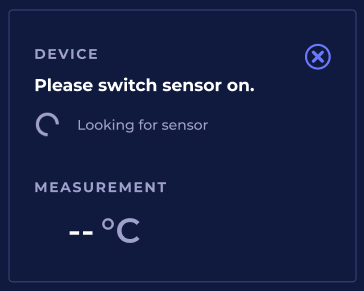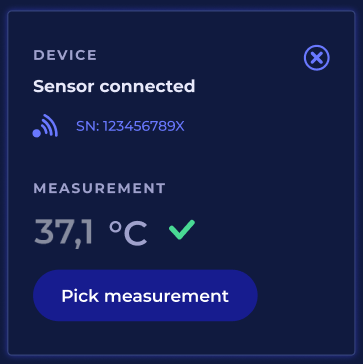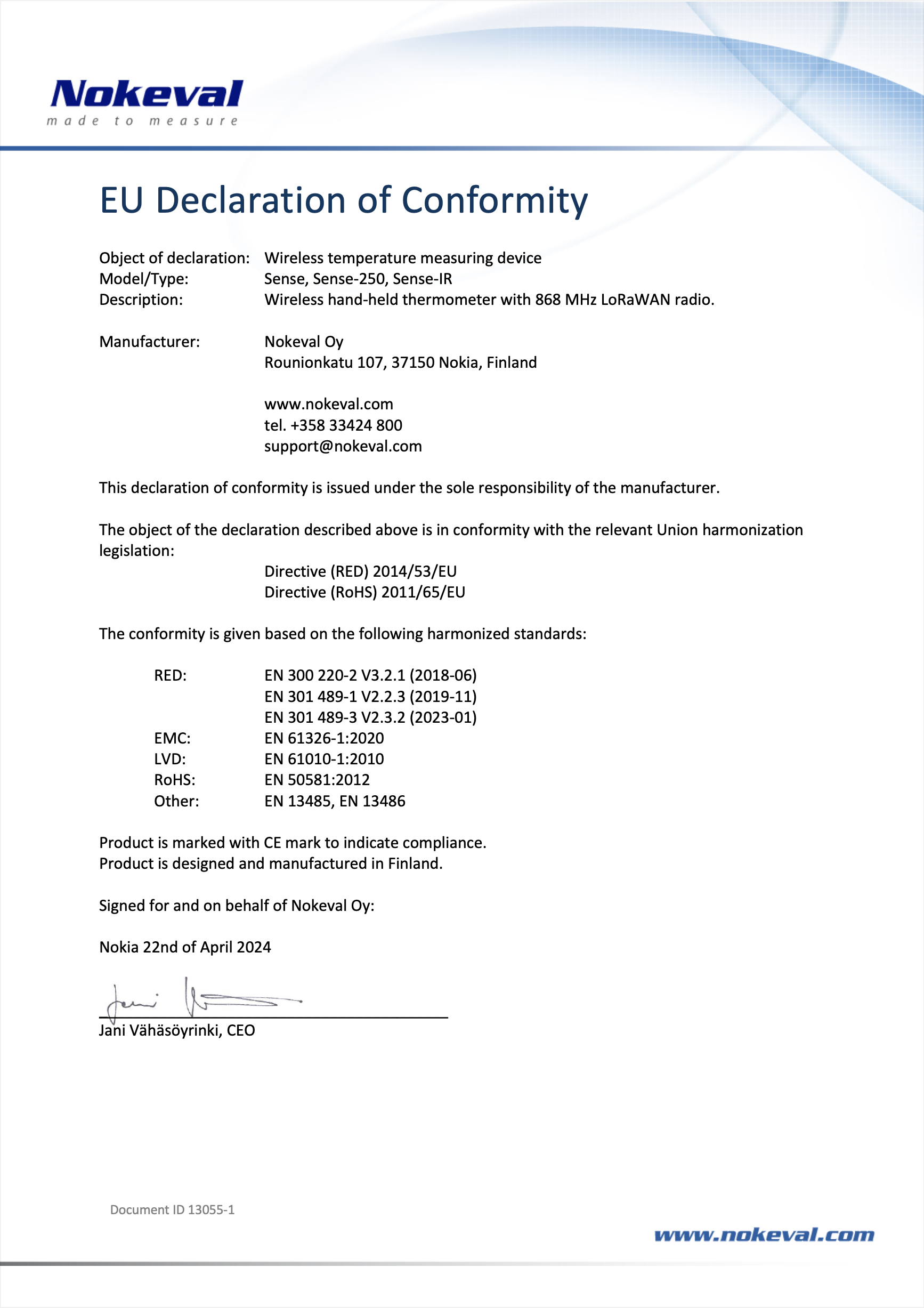NSnappy Sense series
Introduction
Nokeval NSnappy Sense series measuring instruments are wireless LoRaWAN thermometers designed to be used together with the NSnappy service. The product family includes the following models:
NSnappy Sense
Thermometer equipped with a stainless-steel probe with a sharp needle tip. This model is intended for measuring the internal temperature of soft, penetrable products like food.

NSnappy Sense-IR
Non-contact thermometer equipped with an infrared (IR) temperature sensor. This model is intended for measuring the surface temperature of non-reflective objects without touching them.

Installation
No installation is needed as these are portable instruments. Upon shipping, they are automatically registered to the NSnappy service and are ready for use.
Connections
These devices use the LoRaWAN wireless connection standard on the European 868 MHz radio frequency band to send the data to the NSnappy service. There is a fixed radio antenna inside the enclosure. Before using the 868 MHz radio, make sure it is legal in your country.
For the LoRaWAN radio reception to work, an NSnappy Hub-4G-LWEU gateway device needs to be installed on all sites where these instruments will be used. Please refer to the manual of the gateway device for its installation instructions.
Usage
Please refer to the NSnappy user manual for complete instructions on preparing and using the NSnappy service for measuring with Sense LWEU-N series devices.
In short, follow these steps to take a measurement with a Sense device to the NSnappy service:
Log in to your NSnappy service account.
Navigate to the Tasks view.
Either select Enter new measurement or start performing a task that contains entering a measurement result.
Turn on the device by briefly pressing its power button.
Blue LED light on the device starts blinking in bursts of two blinks. This means the device is searching for a wireless LoRaWAN connection.
When the device is connected to the NSnappy Hub device, the blue LED blinks steadily. It can take a few seconds to connect. Note that the device will turn off automatically after 3 minutes to save the battery. If this happens, restart and reconnect the device simply by pressing its power button again.
Measuring results start updating on the screen in the NSnappy service.
Start measuring. Refer to model specific measuring instructions below.
When the reading has stabilized, press the power button again to lock the reading and to turn off Sense device. It can take a few seconds for the measurement to lock on the screen after pressing the power button.
Enter possible additional information and signature to the NSnappy service and save the measurement / execute the task.
The measurement is ready and data is saved to the NSnappy service.


Measuring with NSnappy Sense
Push the sensor probe carefully into the product at least 30 mm deep. Do not use excessive force, do not for example try to push the probe into a frozen or hard product. Be careful also when penetrating plastic foils or similar surfaces. The sensor probe can be damaged or bent if you use excessive force on it.
Wait until the reading has sufficiently stabilized. Note that it can take a few seconds before the readings start updating in the NSnappy service.
You can speed up the measuring process by pushing the probe into the product before the actual measuring process. This way the temperature starts to stabilize even before the first readings appear on the screen.
Measuring with NSnappy Sense-IR
Point the lens of the IR sensor directly towards the target object. Measuring distance should be between 5 to 20 cm. The smaller the target is the shorter the measuring distance should be. The distance should be at most 4 times the smallest dimension of the target object. The surface of the target object must be matte or rough in texture and it should not gleam or reflect light. Shiny or transparent objects cannot be accurately measured.
The reading should stabilize in seconds, but note that it can take a few seconds before the readings first start updating in the NSnappy service. If the result is not what was expected, make sure that the measuring distance is as short as possible. Measurement error of couple of degrees is possible depending on the surface properties of the target object.
Maintenance
These are delicate measuring instruments that need to be handled with care. Even though the case is made of durable plastics and silicone, the sensor probe or internal electronics can be damaged by drops or hard impacts. If there is any suspicion that the device is damaged, send it to the manufacturer to be checked and serviced.
Replacing the battery
These devices are powered with a special 3.6 V Lithium Thionyl Chloride battery pack. The battery is not user replaceable. Annual NSure service and calibration subscription services are available for these devices and these services include a periodic calibration of the sensor and battery replacement. Under normal use and conditions, the battery will last for at least a year. If needed, send the device to Nokeval for service and battery replacement.
Cleaning
It is important to keep the device and especially the sensor probe or lens clean. Clean the device using a soft, non-abrasive cloth moistened with a mild detergent solution. We recommend the NHygiene fiber towels.
Be careful not to scratch the IR sensor’s lens.
Do not use any abrasive devices or substances when cleaning.
Do not clean the device in a dishwashing machine.
Service
There are no user serviceable parts in these devices. If the device needs service, contact your NSnappy service partner for more instructions.
NSure service and calibration subscription services are available for this device and these services include a periodic calibration and battery replacement.
Troubleshooting
The readings do not appear or update in NSnappy
Check that the LED blinks. If the LED is not blinking at all after pressing the power button, send the device for service as the battery might be empty.
Check that the blue LED on the device switches from blinking in bursts of two to blink single blinks. This indicates that the device has connected to the hub device.
If the device keeps blinking in bursts of two blinks, check that there is an NSnappy Hub LWEU-N device for a wireless LoRaWAN connection installed on the site and that you are using a Sense LWEU-N device within a reasonable range from it. Typical range of the LoRaWAN wireless connection indoors is from tens to hundreds of meters, depending on the materials of the building structures.
If the LED blinks single blinks but the readings are not updating in NSnappy, check the serial number of the Sense device and make sure that the same serial number can be found from the Settings → Devices view of the NSnappy service.
The readings appear to be too high or too low with Sense
Make sure that you have inserted the probe deep enough.
Make sure to wait long enough for the readings to stabilize. It can take up to a minute for the readings to properly stabilize.
Check the condition of the sensor probe. If the probe is bent or appears otherwise damaged, it could give incorrect readings.
The readings appear to be too high or too low with Sense-IR
Make sure that you are pointing the lens directly to the target.
Make sure that you are measuring from as close as possible to the target without risking touching the target or getting the lens dirty.
Make sure that the object you are measuring is not shiny or transparent. You cannot accurately measure the temperature of shiny or transparent objects with Sense IR.
Even a transparent plastic foil between the IR sensor and the actual target may distort the temperature readings. If possible, remove any plastic foils before measuring.
The reading only updates with a few second intervals
This is normal. The Sense LWEU-N devices send the data to the NSnappy service with an interval of few seconds.
Specifications
Environment | |
|---|---|
Storage conditions | -40…+60°C, relative humidity 5-95%, non-condensing |
Operating conditions | Sense: -20...+45°C, relative humidity 0-100% Sense IR: -20...+45°C, relative humidity 5-95%, non-condensing |
Protection class | IP65 |
Enclosure material | PC+ABS (Bayblend® T88-4N) |
Dimensions | |
Dimensions | Sense: 224 x 28 x 23 mm IR: 119 x 28 x 23 mm |
Weight | |
Temperature measurement probe (Sense) | |
Probe | 80 mm long (250 mm long for Sense-250), 2 mm diameter, hollow stainless steel probe with sharp tip |
Sensor | Pt100 sensor element inside of the probe tip |
Measuring range | -50…+200°C (theoretical Pt100 linearized range -200...+600°C) |
Accuracy | ±0,5 °C within range -30…+100 °C, when device temperature is +5…+45°C and stable |
Measuring interval | About 5 seconds |
IR temperature measurement (Sense IR) | |
Sensor | Gradient-compensated thermopile infrared temperature sensor with integrated optics |
Mesurement beam | 12°, practical measurement distance 5…20 cm |
Target emissivity | Fixed 0,95 |
Measuring range | -70…+380°C |
Accuracy | ±1 °C within range -20…+100°C, when device temperature is +5…+45°C and stable ±2 °C within range -40…+120°C, when device temperature is +5…+45°C and stable |
Measuring interval | About 5 seconds |
Radio connection | |
Description | LoRaWAN standard, EU 868 MHz frequency range |
Transmitter module | Murata ABZ-093 LoRaWAN modem |
Antenna | Internal |
Compatibility | Nokeval NSnappy Hubs and Cloud Service |
Frequency | 863-870 MHz (LoRaWAN 1.0.2 EU band) |
Power | Max +14 dBm E.R.P. |
Range | Depends on environment, indoors: in good conditions up to hundreds of meters, outdoors: line-of-sight up to 10 km |
Power supply | |
Type | 3.6 V lithium thionyl chloride primary battery, not user replaceable |
Battery life | At least 1 year with 20 minutes of use per day |
Declaration of Compliance

Warnings
This product contains a license-free ISM band (868 MHz) SRD radio transceiver. Observe local regulations concerning the use of such radio transmitters. Never start or use this device near explosion hazard areas or in areas where the use of radio transmitters has been limited, such as in airplanes, near medical instruments, near flammable liquids or chemicals or near explosion work sites.
Do not leave the product in direct sunlight or any other place, like in a parked car, where the temperature can rise to over +50°C. The battery may overheat and cause a fire or explosion hazard.
Read this manual carefully before using the product. Misuse may damage the product or cause other harm. Nokeval assumes no responsibility for any damages caused by inappropriate use or handling of the product.
Only Nokeval authorized services may repair or modify the product. The product contains no user serviceable parts.
The product must not be disposed of in household waste. Observe local regulations concerning the disposal of electrical waste. The device may contain a battery.
Trademarks
All trademarks mentioned and any logos reproduced in this documentation are the legal property of their respective owners. Nokeval and NSnappy are registered trademarks of Nokeval Oy.
Manufacturer
Nokeval Oy
Rounionkatu 107
FI-37150 Nokia, Finland
Phone: +358 3 342 4810
WWW: https://www.nokeval.com
Email: support@nokeval.com
Business ID: 2852422-8
